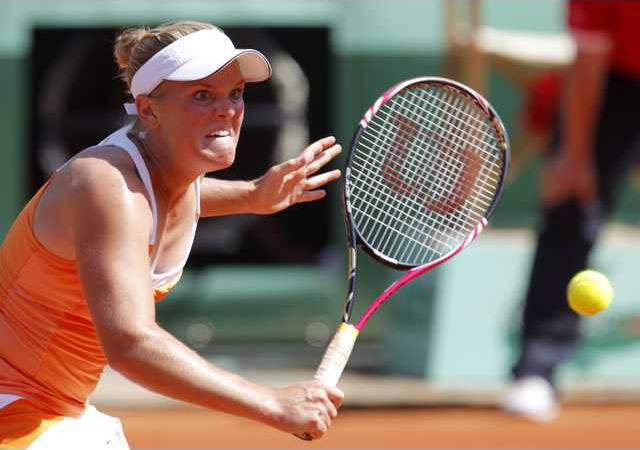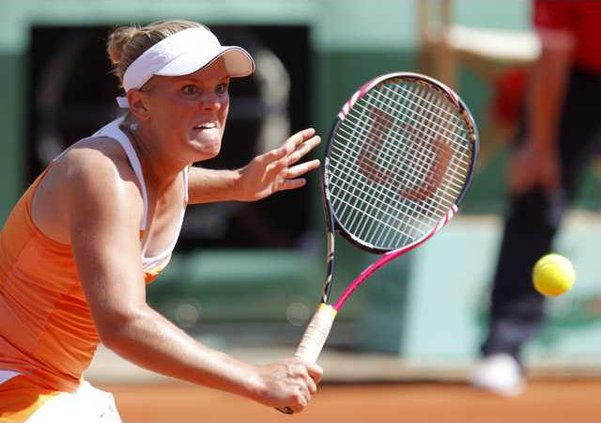PARIS — Summing up a 6-2, 6-0 loss to defending champion Francesca Schiavone at the French Open, Melanie Oudin of Marietta, Ga., said Monday: "Basically, I pretty much got a clay-court lesson."
If the U.S. Tennis Association gets its way, more and more young Americans will be schooled closer to home in the ways of playing on clay.
That's why a significant junior tournament in Florida is switching from hard to clay courts, and why four clay courts were installed last year at the USTA training center where the U.S. Open is held in New York. The idea is not simply to help kids have more success on the slow surface used at Roland Garros, but also to improve their games on faster hard or grass courts.
"I don't get to play on clay, and she's grown up on clay," Oudin said after facing the 30-year-old Schiavone, an Italian. "I mean, she's a lot older than me, like 10 years, 12 years. That definitely helps for experience for her. But also, I mean, she's just really, really good on the clay."
Oudin — best known to date for her surprising, upset-filled run to the 2009 U.S. Open quarterfinals — was one of three 19-year-old women from the United States in first-round action at the French Open on Monday.
As if to highlight the issue of the future of U.S. tennis on clay, all three met older opponents from Europe, and all three lost, none more painfully than Christina McHale of Englewood Cliffs, N.J. She led 5-0 in the third set but let that slip away and was beaten 6-7 (4), 6-2, 9-7 by Sara Errani, a 24-year-old from Italy.
"I just wasn't making my shots anymore, and I panicked, and she started feeding off of that," McHale said, fighting tears, "and before I knew it, it was 5-all."
CoCo Vandeweghe of Rancho Santa Fe, Calif., was eliminated 7-6 (5), 6-2 by 25th-seeded Maria Kirilenko, a 24-year-old from Russia. It was the first time playing at Roland Garros for Vandeweghe, who never entered the French Open junior tournament — and who said her former coach dissuaded her from entering the U.S. junior championships played on the surface.
"I never got to play on clay; I always wanted to," said Vandeweghe, the niece of former NBA All-Star and general manager Kiki Vandeweghe. "My game is pretty good for clay. I don't mind it. I can slide pretty well."
The fourth American woman in action Monday, 36-year-old Jill Craybas of Huntington Beach, Calif., advanced to the second round by beating Eleni Daniilidou of Greece 6-3, 6-3.
Two U.S. men played, and 10th-seeded Mardy Fish of Tampa, Fla., defeated Ricardo Mello of Brazil 6-2, 6-7 (11), 6-2, 6-4, while Alex Bogomolov Jr., of Miami, lost to Marcel Granollers of Spain 6-3, 3-6, 7-6 (6), 6-2.
There hasn't been a U.S. man in the French Open quarterfinals since Andre Agassi in 2003. There hasn't been a U.S. woman other than Serena or Venus Williams in the third round since 2006.
One prevailing theory is that Americans play far less on clay as kids than players from some other parts of the world.
"We were talking about this the other day, a bunch of us: We don't know why there aren't many clay courts in the States. ... It would be kind of good to get a variety, because you learn a lot about your game on different surfaces," Craybas said. "It would be good for kids to kind of play on all different surfaces as they're growing up, but it's tough for Americans, because we don't have a lot of clay courts available. So, I mean, we're always practicing on hard courts when we're younger."
As general manager of player development for the USTA, former U.S. Davis Cup captain Patrick McEnroe is a major proponent of changing that. He wants youngsters from the country to train on clay, as many Europeans and South Americans do.
That's also why he wanted to shift this year's Orange Bowl International Tennis Championships from hard courts back to clay this year.
"You learn how to use the court a lot better; you learn to move a lot better; you learn to hit more balls and construct points," McEnroe said. "It's a lot easier to go from a background of growing up on clay and adjusting your game to a faster surface than it is to go vice versa."
In addition to the four clay courts at the USTA Billie Jean King Nationals Tennis Center, there are 14 at the USTA training center in Boca Raton, Fla., and four at its center in Carson, Calif. Plus, the USTA encourages the 20 privately owned clubs and programs that serve as regional training centers elsewhere in the United States to work with their top young players on clay as much as possible.
"I definitely think it can't hurt to practice on clay," McHale said. "It helps with point construction, patience, and all of that."
The 22 courts at the main USTA centers are all green clay, which is far more common than red in the U.S., primarily because upkeep costs less. McEnroe said that if the green clay is maintained the right way, it's a "very good simulation" of the red.
Oudin's not so sure.
"It's completely different. It's nothing like here," she said. "Green clay courts, you can almost play on it like a hard court in the States. It's a lot faster; the ball doesn't bounce as high."
Most of all, Oudin lamented her unlucky draw: She was forced to face Schiavone, of all people, in the first round at Roland Garros.
"Whenever I come to Europe and play the red clay, I always get Spanish or Italian grinders. I can never get one that hits the ball hard and flat," Oudin said. "So, I mean, I'll be looking forward to the grass-court season."
When it comes to tennis, that's become a familiar refrain for Americans in Paris this time of year.
___
Howard Fendrich can be reached at http://twitter.com/HowardFendrich
Tough day for three American teens





